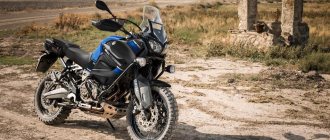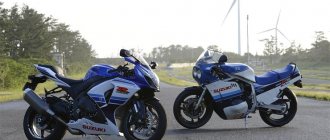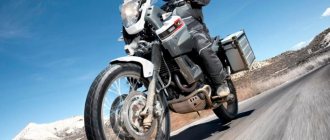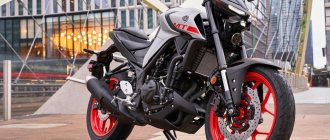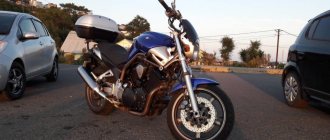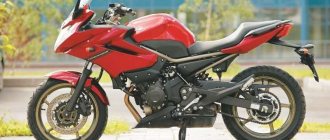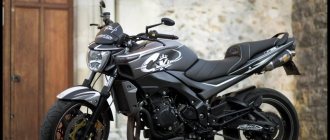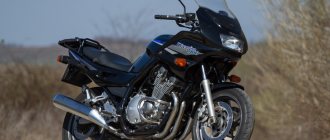For whom
Here are the main features of this machine:
- reliable motor;
- affordable price;
- excellent wind protection;
- high center of gravity;
- not suitable for people of short and average height.
Perhaps this bike is a good choice for those who need an inexpensive touring motorcycle to ride from one city to another, especially if sometimes they have to go off-road. Of course, if you go on a trip around the world, such a bike may not be enough.
Brief history of the model
1991 - production and sales of the Yamaha XTZ660 Tenere model began. The first generation of the motorcycle. Features a rectangular headlight. Maximum engine power is 48 hp, torque is 57 Nm. Model: Yamaha Tenere 660 (XTZ660) (Europe). Factory designation: 3YF1, 3YF2, 4BW1.
1992 - no significant changes. Model: Yamaha Tenere 660 (XTZ660) (Europe). Factory designation: 3YF3, 3YF4, 3YF5, 4BW2.
1993 - no significant changes. Model: Yamaha Tenere 660 (XTZ660) (Europe). Factory designation: 3YF6, 3YF7, 3YF8, 4BW3.
1994 - Second generation of the motorcycle. Instead of a rectangular headlight, the model is equipped with a double round one, and the design of the dashboard changes. Due to the update of environmental emission standards, the model has become a little “stifled” - 46 hp. power, 56 Nm of torque. Model: Yamaha Tenere 660 (XTZ660) (Europe). Factory designation: 4MY1, 4MY2, 4NW1.
1995 - the model is temporarily not produced.
1996 is the last year of production. Model: Yamaha Tenere 660 (XTZ660) (Europe). Factory designation: 4MY3, 4MY4, 4NV2.
1999 is the last year of official sales.
Dimensions and weight
This bike weighs 197 kg including fuel and its tank capacity is 20 liters. Average gasoline consumption per hundred kilometers is 5 liters. The height of the motorcycle at the saddle reaches 865 mm, and its wheelbase is 1495 mm. The bike cannot be called small, like most representatives of the touring enduro class, which makes such motorcycles most suitable for tall people whose height exceeds 180 cm.
Trunk
Excellent and powerful already in stock.
There is complete order here , but the hydraulic settings change right on the go. There are three modes to choose from: Standard, Soft and Hard, divided into seven levels each. Total - twenty-one hydraulic stiffness positions and four preload positions. Together 84 options! On the first day, I simply exhausted myself with searching for optimal values. I stopped for this probably fifty times. Still, a large selection is good, but a small selection is even better! And if in a smart phone it is possible to reset to factory settings, that is, return to the state “from the assembly line,” then this will not work with a motorcycle. In general, on the second day I remembered with sadness and longing the good old “mechanical” Super Tenere, on which I got a thrill from driving, and did not torment my brain with settings options.
TEXT: LIU WASEDA
Chassis and brakes
The frame of this machine is made of steel and is spatial in type. The steering wheel here is typical for the class, and the wheels are spoked. In general, the exterior looks quite interesting, although there are no special frills here.
The rear suspension for the XTZ 660 Tenere is a pendulum version with a monoshock absorber, and at the front this is a 43 mm telescopic fork. The motorcycle brakes using a 220 mm disc and a single-piston caliper at the rear, as well as a 282 mm disc and a two-piston caliper at the front.
TEST DRIVE: Yamaha XT660Z Tenere 2008 – The Nomad is back!
Tenere or Ténéré means “desert” in the language of the Tuareg (North African nomadic tribes). The place itself, called Ténéré, is a vast region in the south of the Sahara, located between Niger and Chad. By the way, “Sahara” also means “desert”, this is a direct translation from Arabic. So before we get started, I'll tell you that all we're going to talk about today is desert driving!
MOTOGONKI.RU, May 9, 2008 — Throwing the Yamaha XT660Z Tenere into the depths of a real desert, exactly where Ténéré belongs, is a very bold step, even for such a manufacturer as Yamaha. But Yamaha decided to throw a big international party in Morocco. After all, in 1983, it was in Morocco that the star of the Yamaha XT600Z Tenere lit up.
If my knowledge of Dakar history is correct, Stéphane Peterhansel competed and won all seven Paris-Dakar rallies in a sports version of the Tenere. Nothing speaks volumes about an off-road motorcycle more eloquently than this! Years after the Peterhansel era, BMW and KTM shared the championship and many victories in the premier class of cross-country rally racing. But, in reality, KTM is a student compared to Yamaha in the world rally game.
The 2008 Yamaha XT660Z Tenere emerges from the clouds of dust like a mirage. I was very pleased to see this bike at the show in Paris in 2007. Design, technical specification and Name (with a capital letter) - everything here is created for desert rallies! The Yamaha factory is actually seriously concerned about returning the legendary Tenere to service, making it a tourer for traveling on all types of roads and off-roads. The motorcycle seems to have been created for the nomads of the Sahara, to replace their camels and horses, and, having replaced them, without losing the feeling of absolute freedom.
After a long and extremely difficult week of traveling around Europe, I was finally able to see the vast expanses of the desert. Here you need to keep your mouth shut, not only because unnecessary words are dangerous, but also because you may not see water for days on end. The trip to the final gathering place was long, so with the greatest pleasure I arrived at the oasis, where I abandoned the motorcycle and began wandering aimlessly among the palm trees, trying to rest in their shade. Partially due to dehydration, partially due to overheating. My head was simply spinning. Finally, I could taste water again! She's sweet. It doesn’t matter that it’s been filtered and disinfected ten times, it’s still sweet.
Upon arrival at Agadir airport, I immediately got to work. From the hotel in Tinsit, I had to move towards the Atlas Mountains. My bike and my girlfriend were waiting at the hotel, and I immediately plunged headlong into the dizzying world of nomadic tribes, becoming one of them.
I drove past vintage Mercedes, these modern camels, most of which have been here since the 70s. We headed for the mountains, beyond the peaks of which lay the greatest desert in the world.
Feeling Tenere in different guises inspired me. Nothing fancy, but I liked the Tenere better than the standard XT660R. No, there’s something different here, the spirit of adventure just lives in the motorcycle or something...
In fact, many of the desert areas we drove through during the test reminded me achingly of the vastness of Southern California. Well, as long as you're on the highway and not in the city. Or you don’t make it to one of the hundreds of checkpoints. No, we are still in Morocco! It's normal here.
Trucks cruising down the highway at 10 mph kept the 50-horsepower XT660Z from taking a deep breath all the way to the mountains. We found this to be a significant plus: while we trudged along the two-lane highway at a snail's pace, we were able to fully appreciate Yamaha's new design, aimed at complete comfort for the pilot and his passenger. Everything is done at the highest level, every detail. Perhaps, in terms of finishing, the Tenere can compete even with the BMW F800GS, but on the road it cannot be compared with the 80-horsepower Bavarian. Yes, Tenere could have been better on asphalt. To win the argument, the XT660Z needs to be driven off the road.
Tenere got a huge 22-liter fuel tank, which is enough for more than 300 km of travel, and I did not spare the engine either in the dunes or on class “A” highways. But the blinking of the reserve light can drive anyone into a stupor: how many hundreds of kilometers is it to the next gas station? I noticed that the “reserve” turns on around 270 km. When the light began to blink especially persistently, and I no longer had a liter of additional fuel with me, except for a few euros in my pocket, I decided to turn back to Tinsit in the hope that there would be enough leftovers for a leisurely journey to the city.
The windshield is made exactly in the Dakar style. Small, but maximally functional. The distinctive features of the model are the headlight and the lower part of the fairing, which somehow reminded me of David Coulthard's profile and his famous jaw. If Transformers were made into motorcycles, Tenere would be the first choice. Would work equally well for LEGO...
The whole appearance is just extremely good! The only thing we were missing in the end were two soft caps that protect the headlight bulbs from moisture and sand. They just unscrewed and disappeared somewhere in the sand... The loss, frankly speaking, is not very serious, but if you happen to get into a sandstorm... I don’t know, it’s better not to get caught.
The hot desert gave me the opportunity to break away. I love standing on the pegs for hours and climbing hill after hill, yes, this is what I wanted! Tenere has a very comfortable standing riding position. Yamaha made this bike for this purpose too, and it shows. The footpegs of my Tenere had rubber inserts, which added comfort on asphalt. But in the sands I completely removed them. It only took a couple of minutes at any time. The Metzeler Tourance tires (90/90-21 front and 130/80-17 rear) were excellent for all test conditions except the dunes.
Once we got off the pavement, I did a little experiment by hooking my Alpinestars Tech 10 gear tabs. In all positions - standing, sitting, standing on one leg. It wasn’t easy enough to look cool in front of photographers in this position, but for myself I concluded that the foot never hung in the middle, each time making a full move and, having solemnly “clicked,” changed gears or put the gearbox in neutral. I spent most of the time allotted for testing in the sand. And while riding the Yamaha did not provide any reason to doubt the reliability of the design, I was completely able to concentrate on the ride itself. Either a huge boulder suddenly appeared on my way, or deep sand, everything went without a hitch.
I was able to test my strength in the first dunes. To be honest, they weren't all that great dunes, but to clear our conscience, we decided to test the Metzeler Tourance on deep, fine sand. I’ll say right away that I wasn’t very pleased every time when, after a fountain of sand from under the rear wheel, I grew into the sand up to my axle. The tread pattern is good on any sand except deep sand.
Morocco is full of stones. Additional crankcase protection is really necessary if you don't want to bury your bike somewhere a couple of hundred kilometers from the highway. While driving through the desert, relatively large stones kept knocking on the aluminum shield! Thinking about a motorcycle as a means for a tourist, you can’t even imagine why this thing might be needed. The large gas tank is somehow more familiar and understandable.
Typically, SUVs are lightweight in essence. Not tourists, of course. Cross, enduro... But, add a couple of aluminum roll bars to any set, some luggage cases, and you get a 250-kilogram mule. Not including the pilot's weight, mind you. Tenere weighs 183 kilos “dry”, but I can’t say that I felt its weight during the test.
The easy-to-use 1-cylinder engine is easy to control. Yamaha based the XT660Z on the XT660R engine, only with greatly reduced power in favor of higher torque. Even compared to “R”, I liked the throttle response more. Perhaps due to the fact that we tested the XT660R in December, when the conditions were completely different. But, whether sand or deep snow... A motorcycle such as Tenere always needs additional cooling. The heatsinks I looked at on the XT660R and MT-03 would not be suitable for a desert wanderer. And here, the Japanese put their heads in the right vector. Together with the increased size of the radiators and filling volumes, the 660 cc “beater” is reliable and resistant to any loads to which I subjected it. 48.4 “horses” is enough to have a serious margin of reliability. I'm glad that here, too, my first thought coincided with Yamaha's idea. For most of the conditions in which I drove the Tenere, this power was sufficient and even with a reserve.
A specially designed 6.8-liter air intake is another secret of excellent throttle response. To make it easier to change the filter during a short rest, the box can be disassembled without the use of special tools. The basic air filter is paper, a design that requires frequent replacement but provides better protection against dust and sand.
The new Tenere exhaust system shows a special design thought from the designers. The muffler ends are raised high into the air, and the pipes are laid neatly on the side of the engine, which allows the ground clearance to be increased to the maximum. Impressive silencers are neatly hidden under the seat and have options for attaching luggage cases. External reflectors eliminate the possibility of burns for the passenger.
With a new steel frame, the Yamaha chassis also features an integrated oil reservoir. You can easily find the “entrance” and a long dipstick to check the level. The rear wheel swingarm is made of profile aluminum, high-tech in Yamaha style. The mono shock absorber has spring preload adjustment, a similar feature on the 43mm fork. To convince future Tenere owners that the “baby” can be stopped in no time, Yamaha turned to Brembo for help: there are two huge discs at the front that grip 2-piston calipers. I didn’t have a chance to test it on the asphalt in emergency mode, but overall the impression was positive. There is enough effort off-road, the only thing is that the response may not be very clear. However, this is a subjective opinion.
The seat height is 895mm and doesn't actually look as high as in the photos. A bike born in desert rallying, converted for touring or not, really needs a lot of ground clearance. That's why this bike, like some others, is significantly higher than its touring counterparts. To drive on sand, you just need huge ground clearance and incredibly long suspension travel. The wind deflector could be called a "bikini", but based on our testing, I guarantee that it is a very well thought out design. In fact, it provides maximum wind protection (in all weather, I assume) when riding seated and wearing an off-road helmet.
If you're lost somewhere in the middle of the desert, Yamaha offers an additional option - a convenient seat for mounting a GPS. In this case, the navigator will be located directly under the dashboard, so you won’t have to be distracted from the road. We were offered a huge catalog of accessories for the XT660Z Tenere already at the opening ceremony.
The motorcycle is available in three colors: “classic” Yamaha color (white-red-black), traditional for Tenere released in 1983, khaki and midnight black.
Total:
I'm still impressed by how much effort Yamaha put into this bike. I dare say that the intense competition with KTM and BMW in the touring and adventure bike segment played a significant role in this. With the rebirth of the XT660R Tenere in 2008, Yamaha returns to this market with its head held high. This is a very good off-road bike and is very comfortable for highway riding thanks to the all-weather windshield and comfortable seats. The Tenere is one of the bikes that makes me feel at home anywhere, from city streets to the Sahara. This is a real all-terrain vehicle.
Pros: + Tenere 2008 is not just a Dakar replica, it works exactly the same. It definitely won't let you down on the way to Dakar! + Huge fuel tank and no need to modify the system to power even the worst gasoline. + Maximum functionality.
Cons: - We lost the headlight protective cover... it just unscrewed and disappeared somewhere in the sands of the Sahara. — A real vibration massager, and you have to put up with it
Thor “Arabian” Sagen, especially for MOTOGONKI.RU from Morocco
Photos: Dentsu Live, Tor Sagen
| The material was prepared with the support of the General partner of the MOTOGONKI.RU portal - SHELL Advance |
